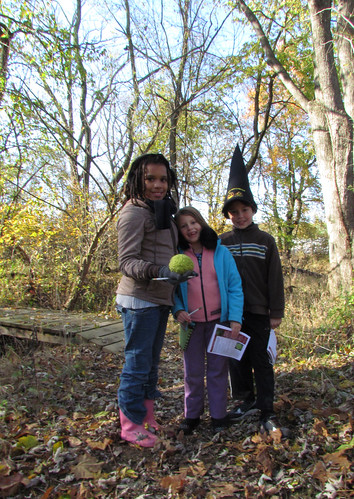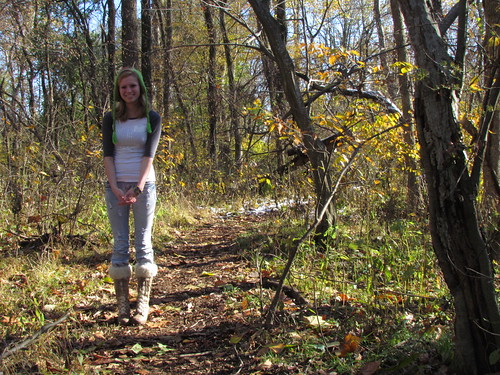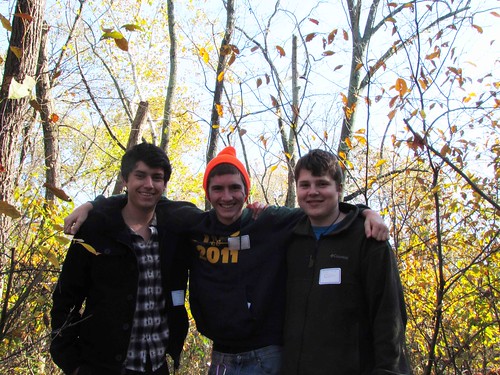Three children romped down the trail, shouting in unison, “We found the Osage Orange! We found the Osage Orange!” The softball-sized fruit, with its bright green, wrinkled shell was the last thing they needed to complete a 26-item scavenger hunt on the Chapman-DeMary Trail in Purcellville — having already discovered hackberry, wild grape, a small island in the creek, a bug on the ground, a good hiding place, and the rest.

The event celebrated fall, as well as the latest round of student-built enhancements on the trail. The new interpretive signs, brochures, and footbridges continued a partnership through which Loudoun Valley High School (LVHS) students worked successfully to create an outdoor classroom and public trail on permanently protected land.
Teenagers from the school’s Environmental Explorations classes were stationed along the trail to help younger children identify what they were seeing, in the same way that their teachers point out elements of the natural world to them: how spicebush provides rich, fatty seeds for migratory birds; how box turtles spread the seeds of Jack-in-the-Pulpit; how a wide range of macroinvertebrates will thrive in a clean stream while far fewer species can tolerate pollution.
“There aren’t very many schools that have something like this,” said Brian Martin, a senior. “Instead of going over PowerPoint like you would in other high schools, it’s hands on… You actually go out and learn cool stuff about what’s going on in the environment that you live in.”
Three friends — juniors Daniel Roca Zela, Ryan Pack and Jake Robic — said that they notice more of what’s happening in nature, now that they can identify some of the species.
Sierra Carter, a junior, also said that their training as naturalists makes her more aware when she’s outdoors. She has learned over 30 kinds of birds — including towhees, blue jays, phoebes, and her favorites, the red-bellied woodpeckers.
“It lets you know what we’re killing!” she burst out.
But she also sees their work on the trail as an example of restoration. “It helps with the environment,” she said. Over the years, students have hauled more than a ton of trash out of this forest, from an old farm dump and from littering. They laid mulch along the mile-long path and built five footbridges. The Environmental Explorations students wrote text for the new signs and brochures, which the visual arts students designed. And it was because of the students’ efforts that these woods were protected and opened for the whole community to enjoy.
“Add in your future goals.”
The trail was created through a partnership that began in 2004, when Gem Bingol, PEC’s Clarke and Loudoun County Field Officer, approached the Environmental Explorations classes about a tree-planting project in the nearby Susan R. Kane Nature Preserve. Planting trees there, in former farm fields along the floodplain of Catoctin Creek, would create a more robust riparian buffer for the creek, stabilizing its banks and filtering stormwater runoff. The classes took up the project, planting over 500 trees in the nature preserve over the next several years.
John DeMary, an Environmental Explorations teacher who retired in 2010 after 38 years at LVHS, recalls that when he started, you could walk five minutes in any direction and find yourself in nature. But, the Town of Purcellville is a designated growth area in rural, western Loudoun, and over several decades of rapid growth, most of its fields and forests had given way to development. So, the woods that the students walked through were now a rarity: a mature forest, with creek and wetland habitats, abundant in native plants and wildlife.

To get there, they followed Catoctin Creek through the woods where the Chapman-DeMary Trail runs now — then, more of a deer path.
The partnership expanded when the Town of Purcellville took an interest in the tree-planting project, in conjunction with a potential reservoir expansion. That would require flooding wetlands, which requires mitigation. The new riparian buffers along Catoctin Creek were one way for the Town to balance out that loss of wetlands.
In 2006, the students made a presentation about their work to the Town Council. As they prepared, DeMary recounts, “I said, make sure you add in your future goals, what you would like to see happen. They said that, since that was the last stretch of mature forest in Purcellville, they’d like to see that area preserved. They’d like to see a nature trail and an outdoor classroom and so on. So, that was their vision for the future.”
The night that the students addressed the Town Council, the owner of the woods, John Chapman, was in the audience because his son, Sam, was part of the class. Chapman took interest in the students’ vision, and eventually he agreed to protect the land with a conservation easement, and to provide public access, on the condition that students built and maintained the trail.
“You see a whole transformation.”
At that point, the woods weren’t necessarily a welcoming place, recalls Kaitlin Pearson, who graduated from LVHS in 2009. They were full of junk, and without the mulch and the footbridges, it could be difficult to negotiate the boggy ground and rivulets feeding the creek.
Pearson, whose family lives in an adjacent neighborhood, sees the improved trail as an asset to the community, as well as the school — a place for families to take their kids or for her to walk with friends. “It adds a family-friendly factor, an adventurous factor,” she says. Purcellville has other parks for sports, and the W&OD Trail for biking, but when people want to bird-watch or explore the woods, she says, “The Chapman-DeMary Trail is the place that they should go.”

The land was formally protected in 2009, through an easement held by the Town, and the trail was named in honor of the landowner, John Chapman, and the teacher, John DeMary. PEC has stayed involved throughout the creation of the trail, securing grant funding for many of the improvements. The Newton-Marasco Foundation, another key player, has also been actively engaged in this project over several years.
Liam McGranaghan, the other Environmental Explorations teacher who was involved from the beginning, says, “I tell my kids, it’s often we talk about the bad things happening to the environment. But we’ve got to look at the positives. Here’s a great example, right here in our own community of people coming together to make this work… I don’t see how you could put a price on that down there.”
The outdoor lab gives students a chance — sometimes their first — to feel at home in nature.
“You see a whole transformation of the students during the course of the year,” McGranaghan says. At first, the kids are nervous about crossing the creek — balancing on stones and possibly getting their feet dirty or wet. Later, they run across. He says, “I think a lot of it is that they’ve never done it… For them, it just opens a whole new world, and they realize that they can do these things, that it’s nothing to be afraid of. You can’t get that from a classroom.”
Sophie Desmond, who graduated from LVHS last spring, says that her experience in Environmental Explorations classes changed her character. As she describes it, “You feel a connection with things that are natural.” For instance, you’ll stop to appreciate the beauty of a tree, instead of passing it by. “And, you can hear stuff in nature, too. Like, if you go down the trail, you can hear everything. It’s not just quiet, you know. It’s actually pretty loud.”
In her lifetime, she has seen many houses go up in what used to be pastures, but, still she finds plenty of wildness among Loudoun’s rolling hills. “It’s not hard to find nature in western Loudoun,” she says, “but I feel like it could be easily taken away.” When she drives home from college, she looks forward to the sight of the mountains and the rural scenery. “If it wasn’t there suddenly, I would feel lost.”
Protecting the trail was important, Desmond says, “because it’s a place for people to go that’s in town that’s still natural and untouched…If you go down there, you can see red-tail hawks flying over. You can hear owls if you go at the right time… I feel that it’s a very good thing that it was able to be conserved because it’s our land. When I was in the class, I felt almost responsible for keeping it there and keeping it clean, because that’s why it was there.”
